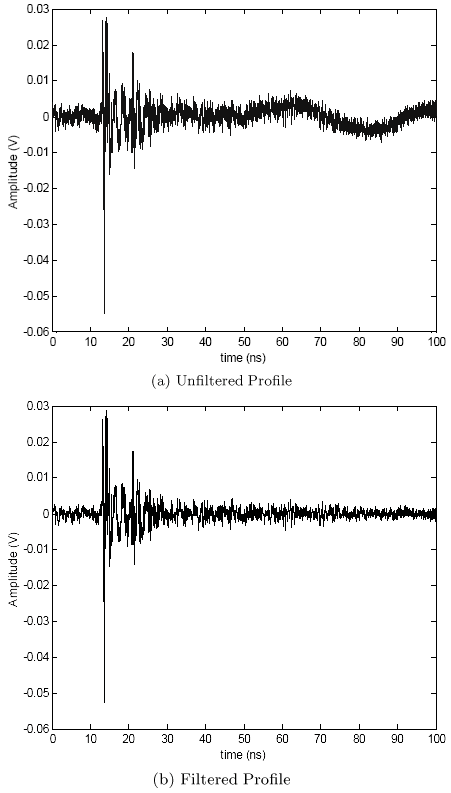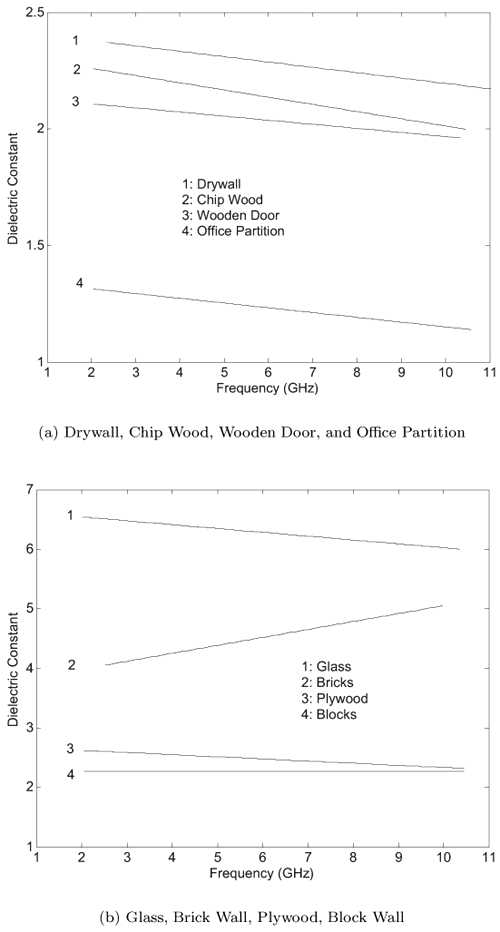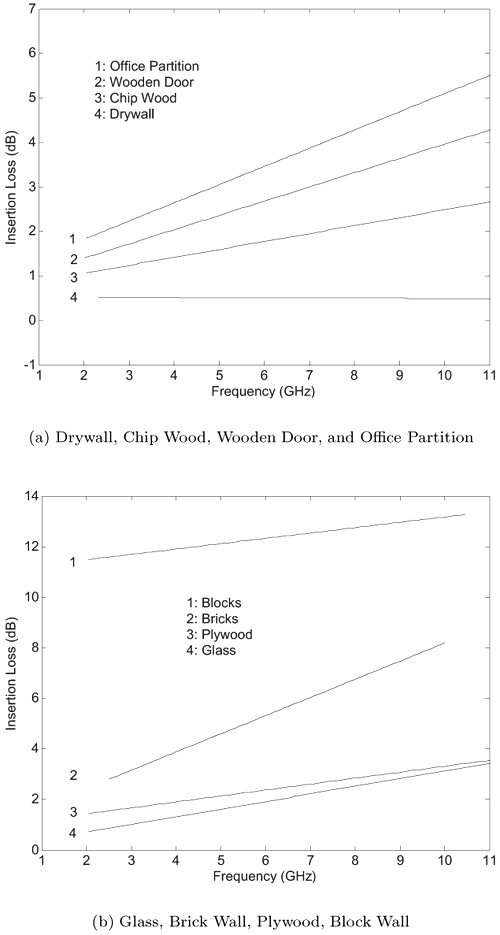Section 2.3. Measurement Results
|
2.3. Measurement ResultsIn this section, measured results for UWB signal propagation in indoor environments are presented. These results are later used to develop UWB channel models. Different groups have carried out extensive propagation measurements for UWB channel modeling and characterization. Among them, researchers at the Communications Sciences Institute, University of Southern California, have been leading the UWB research in recent years. Also, researchers in the Department of Electrical and Computer Engineering at Virginia Tech have been actively involved in research on wireless communications during the past two decades, and more recently have carried out extensive studies of indoor UWB propagation and channel modeling. Here, the research results of these two groups, which for convenience are referred to as the USC group and the VT group, are presented. 2.3.1. Typical Results for Time Domain MeasurementsThe USC group has presented much of the earlier results for time domain channel propagation measurements [7, 8]. However, the VT group has presented both time domain and frequency domain results for UWB channel propagation measurements [9-12]. Both groups have carried out measurements in modern laboratory and office buildings. The USC group used a quasi omni-directional diamond antenna, while the VT group used directive TEM horn antennas, as well as omni-directional biconical antennas. To assess the effect of small-scale fading, the received signal at each receiving position was measured across a square array of points separated by a distance much smaller than the average distance between the transmitting and receiving antennas. Both groups used a square grid with a side length of 90 cm. The USC group considered 7 x 7 = 49 measurement points in the grid, while the VT group viewed 3 x 3 = 9 points in the same size grid as adequate. Figure 2.9 shows the blueprint for the measurement locations used by the USC group, while Figures 2.10 and 2.11 show the blueprints for the measurement locations used by the VT group. Figures 2.12a to 2.12c show the radiated pulses used in the measurements made by each group at a reference distance of nearly 1 meter between the transmitting and receiving antennas. The VT group used a pulse of smaller temporal width and thus larger bandwidth. Shorter pulses are more suitable for discriminating the multipath components. On the other hand, wider pulses generally contain more energy, thus enhancing the signal-to-noise ratio. The characteristics of the transmitting and receiving antennas also play an important role in the time domain measurements. In addition to the propagation channel, antennas may also contribute significantly to the distortion of UWB signals. Therefore, in order to obtain a good estimate of the propagation channel characteristics we must minimize the dispersion effect of the antennas. It is well understood that antennas with wider bandwidths cause less dispersion, manifested by fewer ringing effects. Here, the bandwidth of an antenna is defined as the frequency range over which the gain, the input impedance, and the polarization of the antenna remain nearly constant, while the phase of the radiated far field varies linearly with frequency. In this regard, the TEM horn antenna with a radiated pulse as that shown in Figure 2.12b is the best example of the three pulses. The biconical antenna, which is viewed as a wideband antenna, has a nonlinear phase behavior with frequency and thus causes signal distortion, as is noted in its radiated pulse shown in Figure 2.12c. The behavior of the diamond antenna, shown in Figure 2.12a, is an intermediate case between the TEM horn antenna and the biconical antenna. More details about the effects of the antenna structure on the UWB channel measurements are provided in Section 2.3.4. Figure 2.9. Diagram of Office Building Where Propagation Measurements of the USC Group Were Performed. The Concentric Circles Are Centered on the Transmitting Antenna and Are Spaced at 1 m Intervals.SOURCE: M. Z. Win and R. A. Scholtz, "Characterization of Ultra-Wide Bandwidth Wireless Indoor Channel: From Statistical Models to Simulation," IEEE Journal on Selected Areas in Communications, [8]. © IEEE, 2002. Used by permission.  Figure 2.10. Blueprints for Several Locations in Whittemore Hall at Virginia Tech. Squares Represent Transmitter Locations, Circles Represent Receiver Locations. Figure 2.11. Blueprint for Fourth Floor of Durham Hall at Virginia Tech. Squares Represent Transmitter Locations, Circles Represent Receiver Locations. Figure 2.12. Waveforms of Radiated Pulses Measured at Reference Point 1 m Away from the Transmitting Antenna. Figure 2.13 shows the 1,000 ns-long measurement of the USC group, where two back-to-back multipath measurement cycles are captured by the receiver located in offices U, W, and M, as shown in Figure 2.9. The approximate distances between the transmitter and the location of the measurement grid located in offices U, W, and M are 10 m, 8.5 m, and 13.5 m, respectively. Figure 2.13 also shows that the response of the first probing pulse decays to negligible levels before the next pulse arrives. An excess delay on the order of 100 ns occurs in these situations. Substantial differences in the noise level at various locations throughout the building can also be observed from Figure 2.13. In particular, the profiles recorded in offices W and M have a substantially lower noise level compared with the profiles recorded in office U. A possible explanation may be given by examining the floor blueprint shown in Figure 2.9. It is noted that office U is situated at the edge of the building with a large glass window, and is therefore more vulnerable to external interference. On the other hand, offices W and M are situated roughly in the middle of the building. Furthermore, office W is situated in the vicinity of room R, and office M is adjacent to room R, which is shielded from electromagnetic radiation. Therefore, the external electromagnetic interference (EMI) is mostly attenuated by the shielded walls and multiple reflections by other regular walls, resulting in less noise in the central area of the building. Figure 2.13. Two Back-to-Back Cycles of 1,000 ns-Long Averaged Multipath Measurement Captured by Receiver Located in Offices U (Upper Trace), W (Middle Trace), and M (Lower Trace) where the Measurement Grids are 10, 8.5, and 13.5 m Away from Transmitter, Respectively.SOURCE: M. Z. Win and R. A. Scholtz, "Characterization of Ultra-Wide Bandwidth Wireless Indoor Channel: From Statistical Models to Simulation," IEEE Journal on Selected Areas in Communications, [8]. © IEEE, 2002. Used by permission.  The VT group carried out time domain measurements using Gaussian-like pulses with a FWHM (full-width half-maximum) of 85 ps. Also, this group used two low noise wideband amplifiers, with a gain of 10 dB and a 3 dB bandwidth of 15 GHz, on the receiving side. Two different sets of measurements were performed using directional TEM horns and omni-directional biconical antennas. Both transmitter and receiver antennas were placed on plastic moving carts at an elevation of about 1.25 m above the floor. Styrofoam slabs were used to adjust the elevation without introducing reflections around the antenna. Nearly 400 profiles were collected on different floors of two different buildings. Sample time domain measurement results by the VT group are shown in Figures 2.14 and 2.15. Figure 2.14a shows the raw data for a typical time domain measurement using two biconical antennas in the measurement setup. The presence of narrowband noise is clearly seen in the tail of the profile. Figure 2.14b shows the same profile after this narrowband noise has been filtered. The level of background noise is determined by the tail of the signal profile. The VT group set the threshold of the signal level at 6 dB above the background noise level. Accordingly, in the channel characterization analysis, the precursor and all signals below this threshold level are forced to zero. Figure 2.15 shows a zoomed profile in the first 20 ns time window to illustrate some details of multipath components. The antennas used in this measurement were TEM horns. Figure 2.14. Unfiltered and Filtered Time-Domain Profiles Measured with Biconical Antennas. Figure 2.15. Time-Domain Profile Measured with TEM Horn Antennas in the Second Floor Hallway of Whittemore Hall at Virginia Tech. 2.3.2. Typical Results for Frequency Domain MeasurementsAll frequency domain results presented here are based on amplitude measurements and the use of the Hilbert Transform for phase calculations. Figure 2.16 illustrates sample frequency domain responses by the VT group obtained with TEM horn antennas in the 2nd floor of Whittemore Hall at locations E, F, and G (see Figure 2.10a). The results for the same measurement locations, but obtained with omni-directional biconical antennas, are shown in Figure 2.17. The measurements in both cases were carried out over a frequency range of 100 MHz to nearly 12 GHz. It is noted that the frequency domain responses over this wide frequency range are characterized by multiple peaks and valleys formed due to constructive and destructive interference of multipath components. The results in Figures 2.16 and 2.17 are for a LOS scenario. Typical frequency domain responses for a NLOS scenario measured with TEM horn and biconical antennas are shown in Figure 2.18. It is noted that the signals for the NLOS scenario vary more rapidly with frequency than those of the LOS. This is because in the NLOS case, more multipath components reach the receiver, creating the possibility of more constructive and destructive interference. Also, a comparison of responses measured with TEM horns and with biconical antennas for the NLOS scenario reveals that the average signal power level in the latter case is generally greater than that in the former case. This can be attributed to the fact that biconical antennas are omni-directional, resulting in more multi-paths reaching the receiver. Figure 2.16. Measured Frequency Domain Responses Obtained with TEM Horn Antennas in the Second Floor of Whittemore Hall at Different Locations. Figure 2.17. Measured Frequency-Domain Responses Obtained with Biconical Antennas for the Same Locations as Figure 2.16. Figure 2.18. Typical Frequency-Domain Responses for a NLOS Scenario. 2.3.3. The Role of AntennasThe antennas used in UWB links can have a significant impact on channel propagation measurements. Radiation properties of antennas, such as input impedance, gain, effective aperture area, polarization, and radiation pattern, and their behavior with frequency, can contribute to pulse dispersion and influence the waveform structure of the received signal, particularly with regard to the number of multipath components and their relative strengths. Only when all antenna properties satisfy certain requirements over the bandwidth of the UWB signal does the signal not suffer any degradation caused by the transmitting and receiving antennas. For example, the input impedance of a UWB antenna and its polarization and radiation pattern should remain unchanged over the bandwidth of the signal, whereas the gain may vary with frequency in such a manner that the radiated field becomes proportional to the time derivative of the signal feeding the antenna, as in a TEM horn. It is emphasized that a mere differentiation of the signal with respect to time is not generally regarded as distortion. Another important factor, which is not an issue in narrowband systems, is the phase of the radiated field. The phase characteristic must be linear in order to avoid further signal degradation. Thus, antennas intended for UWB applications are desired to be UWB in terms of the multitude of properties mentioned above. Even if bandwidth requirements for antennas are ideally met, one should not assume that the propagation channel has a performance independent of the antennas. For example, considering two antennas, both satisfying the same requirements over the bandwidth of the signal but one directive and another omni-directional, the directive antenna generally produces fewer multipath components than the omni-directional one and therefore different waveforms for the respective received signals. This effect becomes more pronounced for NLOS scenarios. The choice of antennas, among other things, is dictated by the intended application. For point-to-point UWB applications, directive antennas are more suitable. On the other hand, for broadcast purposes and for mobile applications when antennas may not be at fixed locations, omni-directional antennas are a more appropriate choice. A more complete discussion of UWB antennas is presented in Chapter 4, "Antennas." 2.3.4. Impact of Building Architecture and Properties of Building MaterialsThe interior design of buildings, and the materials used in their construction, can have a significant impact on the propagation of UWB signals. Walls made of reinforced concrete or metallic studs severely attenuate the through-wall propagation of UWB signals, whereas some other walls, such as those made of wood, glass, and drywall, allow substantial transmission. An assessment of electrical properties of building materials in the UWB frequency band is very useful for simulation of UWB propagation in indoor environments and in designing indoor UWB systems. Knowing the complex dielectric constant of a wall, one is able to determine the insertion loss, as well as the distortion that a UWB signal may suffer upon propagating through it. The VT group has conducted a comprehensive ultra wideband characterization of common building materials, including wooden doors, brick walls, concrete block walls, drywall, chip wood, glass, and fabric covered metal office partitions. The measurements were carried out in both the time and frequency domains using an insertion transfer function approach [13]. Figures 2.19 and 2.20 illustrate variations of the relative permittivity and insertion loss versus frequency for eight common building materials. Figure 2.19. Variations of Dielectric Constant versus Frequency. Figure 2.20. Variations of Insertion Loss versus Frequency. The architecture of an indoor environment also has a major impact on the propagation of UWB signals. For example, narrow hallways and corridors have the characteristics of lossy waveguides that guide the energy in the LOS direction, especially when directive antennas are used. This behavior is not observed in large rooms, where the received energy is mainly due to the direct path from the transmitting antenna to the receiving antenna. For NLOS propagation, the situation is completely different, and is more complicated. In this case, the signal travels along different paths, penetrates through different walls, and undergoes multiple reflections, refractions, and diffractions. All these phenomena greatly affect the shape of the received signal. |
|
EAN: 2147483647
Pages: 110


